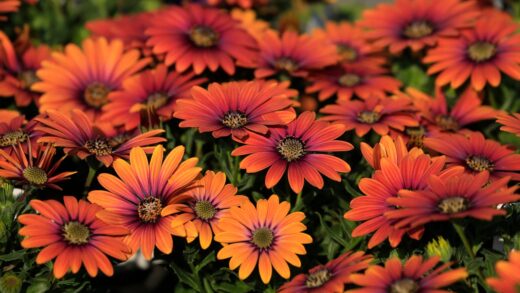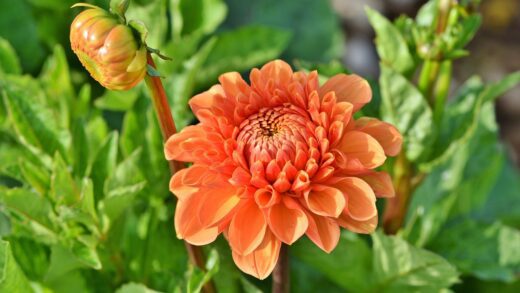Understanding the water requirements of the clustered tulip is fundamental to its successful cultivation, as both under and overwatering can be detrimental to the health of the bulb. Hailing from the mountainous regions of Central Asia, this species is adapted to a climate with dry summers and moisture primarily during its spring growth period. This natural cycle is the most important clue for any gardener; the key is to provide adequate moisture when the plant is actively growing and to ensure conditions are kept relatively dry during its summer dormancy. Incorrect watering is one of the most common reasons for failure with species tulips, often leading to bulb rot or poor performance in subsequent years.
During the autumn, after the bulbs are planted, a single, thorough watering is typically all that is required. This initial irrigation helps to settle the soil around the bulbs, removing air pockets and providing the moisture needed to stimulate the development of roots before winter sets in. Throughout the winter, in most temperate climates, natural precipitation in the form of rain and snow provides sufficient moisture. The bulbs are dormant and have very low water needs during this period. It is only in exceptionally dry, arid winter climates that supplemental watering might be considered, but this is a rare necessity.
The critical period for watering begins in the spring when the shoots emerge from the soil. As the leaves develop and the flower stalks begin to rise, the plant’s demand for water increases significantly. This is the time of active growth, and a consistent supply of moisture is crucial for the development of strong stems, healthy foliage, and vibrant flowers. If the spring season is dry with infrequent rainfall, supplemental watering will be necessary. The goal is to keep the soil evenly moist but never waterlogged. A deep watering once a week is generally more effective than frequent light sprinklings, as it encourages the roots to grow deeper into the soil.
Once the flowering period is over, the approach to watering must change dramatically. As the foliage begins to yellow and die back, the plant is entering its dormant phase, and its water requirements plummet. This is the time to reduce and eventually cease all supplemental irrigation. The bulbs need a warm, dry period during the summer to ripen properly, which is essential for setting the flower bud for the following year. Continuing to water during this dormant period is a common mistake that creates the damp conditions perfect for fungal diseases and bulb rot, which can quickly destroy an entire planting.
Watering during the active growth phase
Spring is the season of vigorous growth for the clustered tulip, and it is during this time that its need for water is at its peak. From the moment the first green shoots push through the soil until the flowers begin to fade, a consistent and adequate supply of moisture is vital. This water is essential for all the plant’s metabolic processes; it transports nutrients from the soil to the leaves, maintains turgor pressure which keeps the stems and leaves firm, and is a key component in photosynthesis. Insufficient water during this critical phase can lead to stunted growth, weak stems that are unable to support the multiple flower heads, and a diminished or short-lived floral display.
The best way to gauge the need for watering is to check the soil moisture regularly. The frequency of irrigation will depend heavily on your local climate, weather patterns, and soil type. Sandy soils drain quickly and will require more frequent watering than clay-based soils, which retain moisture for longer. As a general rule, the top few centimetres of soil should be allowed to dry out slightly between waterings. When you do water, do so deeply and thoroughly, aiming to moisten the soil down to the level of the bulbs, which is about 15 centimetres deep. This encourages the root system to grow deeper, making the plant more resilient to short dry spells.
It is generally better to water in the morning. This gives the plant’s foliage ample time to dry off during the day, which helps to reduce the risk of fungal diseases that thrive in damp conditions. When watering, try to apply the water directly to the soil at the base of the plant, rather than overhead. Wetting the flowers and leaves unnecessarily can make them more susceptible to diseases like tulip fire (Botrytis tulipae). Using a soaker hose or a watering can with a long spout are effective methods for delivering water directly to the root zone where it is needed most.
It is important to strike a balance and avoid overwatering, even during the active growth period. While the tulips need consistent moisture, they cannot tolerate sitting in saturated, waterlogged soil. This condition deprives the roots of oxygen and creates an ideal environment for rot-causing fungi and bacteria. Always ensure your planting site has excellent drainage. If you notice water pooling on the surface after a heavy rain or after watering, it is a clear sign that the drainage is inadequate and needs to be addressed to ensure the long-term health of your tulip bulbs.
The importance of summer dormancy
The transition from a moist spring to a dry summer is a critical part of the clustered tulip’s natural life cycle, and mimicking this is essential for its perennial success in the garden. After the flowers have faded and the foliage has completely died back, the bulb enters a period of dormancy. During this summer rest period, the bulb requires warm and, most importantly, dry conditions. This dry dormancy is not simply a period of inactivity; it is a crucial ripening phase during which the flower bud for the following spring is formed within the bulb.
For gardeners, this means a significant shift in watering practices. All supplemental irrigation must be stopped once the leaves have yellowed. Continuing to water the area where tulips are planted during the summer is one of the surest ways to cause the bulbs to rot. Many gardeners plant tulips amongst other perennials or annuals that require regular summer watering, which can create a conflict. To avoid this, it is best to plant species tulips in dedicated beds, rock gardens, or alongside other drought-tolerant plants that share similar requirements, such as certain sedums, lavenders, or ornamental grasses.
The need for a dry summer rest explains why clustered tulips, and species tulips in general, perform so well in regions with a Mediterranean-style climate, characterized by wet winters and hot, dry summers. In climates with significant summer rainfall, cultivating these tulips can be more challenging. In such areas, ensuring the planting site has exceptionally sharp drainage is non-negotiable. Planting in raised beds, on slopes, or in gravelly soil can help to mitigate the effects of summer wetness by allowing moisture to drain away from the bulbs as quickly as possible.
In very wet summer climates, some dedicated growers even resort to lifting the bulbs each year. Once the foliage has died down, the bulbs are carefully dug up, cleaned of soil, and stored in a warm, dry, and well-ventilated place, such as in a mesh bag in a garage or shed. They are then replanted in the autumn. While this is a labour-intensive process, it is the most reliable way to provide the bulbs with the exact dry dormant conditions they need to thrive and flower year after year in an otherwise unsuitable climate.
Watering container-grown tulips
Cultivating clustered tulips in pots and containers offers a wonderful way to enjoy their beauty up close, but it requires a more hands-on approach to watering compared to garden-grown plants. The limited volume of soil in a container dries out much more quickly than garden soil, making the bulbs entirely dependent on the gardener for their moisture needs. During the spring growing season, you will need to monitor the pots daily, especially during warm or windy weather. The compost should be kept consistently moist, but not soggy. A good method is to water thoroughly whenever the top 2-3 centimetres of the compost feels dry to the touch.
When watering container-grown tulips, it is important to do so thoroughly until you see water starting to escape from the drainage holes at the bottom of the pot. This ensures that the entire root ball is moistened and also helps to flush out any build-up of salts from fertilizers. After watering, allow the pot to drain completely and never let it stand in a saucer of water for extended periods, as this will lead to waterlogged conditions and certain bulb rot. The choice of potting medium is also crucial; a free-draining mix, usually labelled for bulbs or containing added grit or perlite, is essential for success in containers.
Just as with garden-grown tulips, the watering regime for potted tulips must change dramatically after flowering. Once the blooms are spent and the foliage begins to yellow, gradually reduce the frequency of watering. When the leaves have completely died back, stop watering altogether. The pot should then be moved to a sheltered, dry location, such as against a sunny wall or in a rain shadow, where it will not be exposed to summer rains. This provides the dry dormant period that the bulbs require.
Some gardeners choose to empty the pots after dormancy begins, storing the bulbs in a dry medium like sand or vermiculite until it is time to replant them in fresh compost in the autumn. This method has the advantage of allowing you to inspect the bulbs for health and to use the container for summer-blooming annuals. Alternatively, you can leave the bulbs in their pots for the summer. If you choose this option, it is absolutely critical that the pot is kept dry. Turning the pot on its side can be an effective way to prevent rain from entering and saturating the compost during their dormant phase.
Recognizing signs of incorrect watering
The health and appearance of a clustered tulip plant can provide clear visual cues as to whether its water needs are being met correctly. Both overwatering and underwatering cause stress to the plant, and learning to recognize the signs is key to correcting the issue before irreversible damage occurs. Being observant allows the gardener to fine-tune their irrigation practices to create the optimal conditions for these beautiful spring bloomers. Early detection and intervention are crucial for maintaining the long-term vitality of the bulbs.
One of the most common problems is overwatering, especially in poorly drained soils. The primary symptom of waterlogged conditions is the yellowing of the leaves, starting from the tips and progressing downwards, often during the active growing season. The plant may appear wilted and stunted, which can be misleading as wilting is also a sign of dryness. However, with overwatering, the soil will be damp, and the base of the stem may feel soft or mushy. In severe cases, the bulb itself will begin to rot, and the entire plant can be easily pulled from the ground with few or no healthy roots attached.
Underwatering, on the other hand, also presents a distinct set of symptoms. If the plant does not receive enough moisture during its spring growth phase, the leaves may appear limp, wilted, and may have a greyish-green or bluish cast. The edges of the leaves might turn brown and crispy. The growth of the plant will be noticeably stunted, and the flower buds may fail to develop properly or may open prematurely while still small. The flowers that do open will be smaller than usual and will have a very short lifespan, fading and drying up quickly.
It is also important to recognize the signs of incorrect watering during the dormant period. The most significant danger during summer dormancy is excess moisture. While there are no visible leaves or stems to show signs of distress, the damage is happening underground. If bulbs are kept in damp soil during the summer, they are highly susceptible to fungal and bacterial rots. The only sign of this might be a complete failure of the bulbs to emerge the following spring. When digging in the area, you may find only remnants of rotted bulbs or nothing at all. This highlights the critical importance of ensuring a dry summer rest.


















